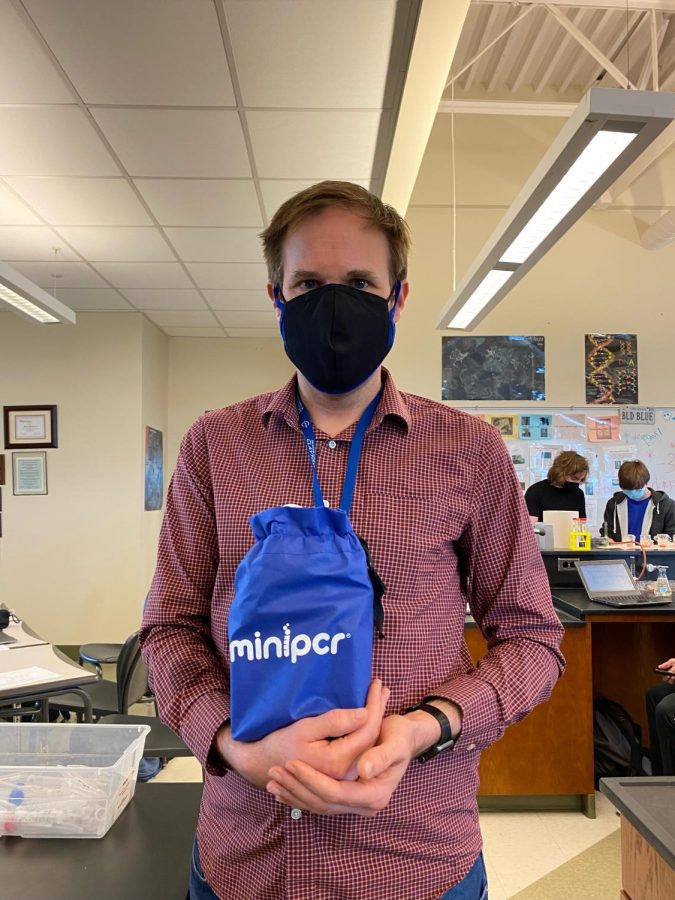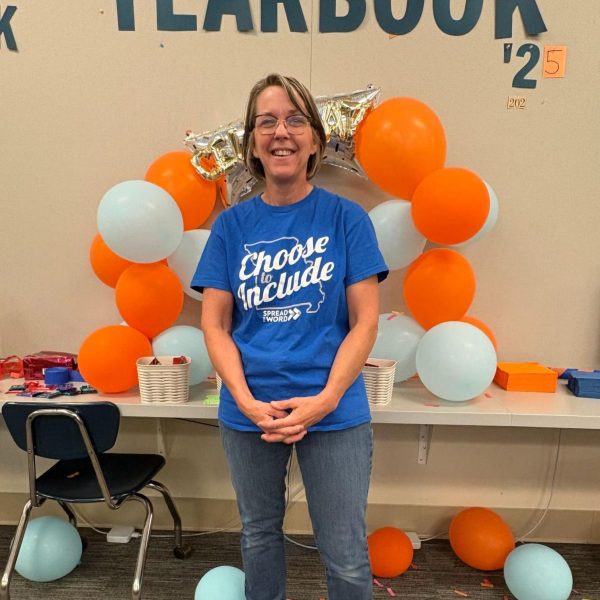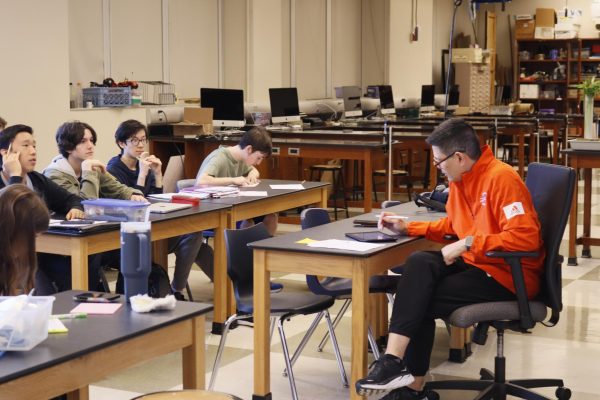COVID Testing at Clayton
Adam Bergeron holds up one of the school’s PCR machines that he hopes will be incorporated into the science curriculum at the high school.
Adam Bergeron, a science teacher at Clayton High School, says he has the answer to the COVID-19 test shortage Clayton is experiencing.
With the recent spike in COVID-19 cases, many students and staff members are in need of polymerase chain reaction (PCR) testing, a biochemical process that allows one to amplify millions of copies of a specific strand of DNA and see if they test positive for coronavirus. Due to CDC guidelines as well as CHS COVID-19 policies, many students and staff are missing school for long periods of time as they are unable to get a negative test result due to the testing shortage.
Bergeron explained how these individuals would not have to quarantine as long if CHS had a system in place that was able to test individuals for COVID-19.
Past students of Bergeron’s Biomedical Innovations class, now seniors at CHS, successfully helped brainstorm ways to establish a testing procedure. “We could take a sample in 30 seconds and have the results for you in less than 90 minutes. Nothing has to be sent out. The samples can be collected here in the building, they could be analyzed here, and we could get you your results by lunchtime,” said Bergeron.
CHS has the equipment necessary for PCR testing.
“What coronavirus testing does is isolate individuals’ genetic material of that virus and use it as source material to amplify through PCR bits and pieces of that virus’s genetic material,” said Bergeron. “Through the amplification one can literally see whether or not that sample has been amplified or not. That is really what these tests give us.
“What we need are reagents or chemicals,” he explained. As soon as the sample goes into the collection tube these chemicals would immediately inactivate the virus making it 100% non-infectious.
In Bergeron’s immediate search he found that the prices for these chemicals are higher at the moment due to the demand for them. But he believes they are all within the range where we could certainly do small group testing and even whole school testing every couple of weeks.
“Honestly, I look at this as a worthwhile investment regardless of the cost. If the trade off is children being able to attend school or not due to isolation or quarantine, the cost is fully worth it,” said Bergeron.
“[The school district] shouldn’t have to arbitrarily say, ‘If you are vaccinated you are out for 5 days, and if you aren’t you are out for 10 days.’ We want to be able to bring students into a safe school setting. The Clayton School District should be able to determine when a student is safe to return to the classroom as soon as possible.”
Beregeron assures there are no risks, only benefits. By having timely and accurate information, CHS would have a clear snapshot of who really has the virus, who doesn’t have the virus and how widespread infections are.
Right now, the belief is that in-school transmission is low. However, no one is testing asymptomatic people, so no one really knows where the transmission is taking place.
“It is hard to come to terms with it because we have been living with this pandemic for almost 2 years; this is not over,” Bergeron said. “We are going to be dealing with this for a long time. And as long as the majority of planet Earth remains unvaccinated, there are going to be new variants.”
Bergeron described how the skepticism over vaccination brings him great sadness. “The fact that we are defaulting to a complete lack of science understanding as a means to make a decision, which not only affects personal health but public health, is a failure of life science education in general. Understanding a virus is difficult, but understanding how your immune system responds to vaccination is even more challenging. These topics should be integrated into future versions of our curriculum in meaningful ways,”
he said.
He explained that the best thing one can do is get vaccinated and receive a booster shot if they want life to return to normalcy. Otherwise, the next variant could be even more transmissible than those so far. “That could be a travesty,” Bergeron said, “but a preventable one.”
A $50 or more donation includes a subscription to the Clayton High School Globe 2024-2025 print news magazine.
We will mail a copy of our issues to the recipients of your choice.
Your donation helps preserve the tangible experience of print journalism, ensuring that student voices reach our community and that student democracy thrives.

Sofia is currently a junior at CHS and it's her third year on the Globe. She is currently a page editor. Sofia is excited about learning new techniques to become a better storyteller...

Hannah is in her third year on the Globe staff and is a page editor this year. She joined Globe to learn more about her new community, after joining the school district in 2020.






